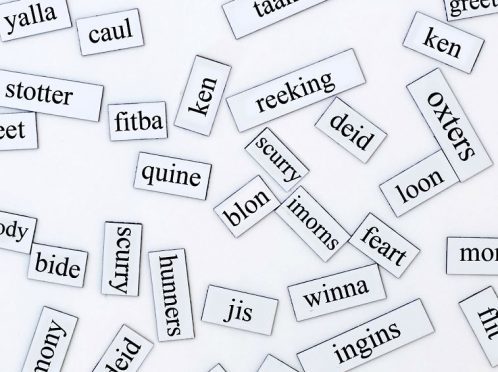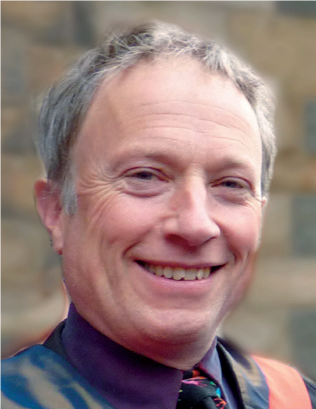The North-East o Scotlan is hame tae a winnerfu heirskip o wird, music, ballad an sang, story, history, an folklore, as weel as the creativity o the fowk fa bide an wark here.
Een o the foremaist pairts o this heirskip is North-East Scots, aften kent as ‘Doric’, bit by mony ither names as weel – Mearns, Toonser, Aiberdeen, Fisher Doric, Buckie, oor tongue, spikkin, an mair. For mair nor a hunner year, North-Easters comin tae skweel wid be lerned, or fyles coercit, tae ‘talk’ raither nor ‘spik’; spikkin meant the language o hame an hert, fyles English wis thocht tae be necessary fer skweel, varsity, an makin a success o life. Sic a history means Doric is nae aften eesed in aa waaks o life; ye dinna hear eneuch sic vyces in o the media, in ceevic life, nor in oor skweels.
Bit the leid o hame, turns oot, is fit’s needed fer real progress. Real progress is nae jist aboot deein weel in education or gettin a gweed job, bit aboot raisin bairns wi confidence in their ain sels, their culture, their tongue, an in their communities. An fit wey can that be deen? Studies in a nummer o countries hae shown that lernin bairns in their ain tongue, the tongue o hame, gies a heeze tae their confidence, bit mair nor that tae their achievement in ither subjecks, an aa, sic-like Maths and English. Big yersel a confident bairn an ye’ve made a success o’t.
For a gey lang fyle, oor tongue his been thocht o as ainly suitable fer hame, hearth, an playgrun, bit afore that it wis a gey influential tongue, in coorts, leeterature, an international affairs – oor ain Bishop William Elphinstone, foonder o Aiberdeen Varsity, communicatit in Scots, Latin, an French durin his time in Paris, as Billy Kay tells us.
The Census fae 2011 tells us that mair nor 1.5 million fowk report themsels as Scots spikkers. In oor airt, aroun 49% are spikkers an, in mony airts, Doric/Scots spikkers mak up the maist o fowk. The North-East is truly a hertlan o the tongue.
It’s time tae pit oor tongue back intae aa neuks o North-East life. Nae bringin back aul fer things we dinna eese noo, bit raither eesin oor ain tongue – an the wey o thinkin that gings wi’t – in ither airts. Fit wey are there gey fyow North-East vyces tae be heard in oor media? Fit wey dae we nae eese it in business meetins? We aa ken fowk fa spik at wark, bit as seen as we’re in a formal settin, years o habit kicks in an we ‘talk’.
At Aiberdeen Varsity’s Elphinstone Institute (www.abdn.ac.uk/elphinstone), we’re yokin wi pairtners aa throu the North-East tae bring oor tongue tae the fore, aimin tae help fowk nae be fleggit tae embrace their tongue in ony wak o life. Ye canna be fit ye canna see (or hear), sae we maun tyauve awa tae gie the tongue mair presence in o the media, mair eese in education an ceevic life, an mair recognition and a heeze fae the Parliament.
In tryin tae chynge thinkin an policy anent Doric/North-East Scots, we’re lernin mony lessons fae the wardle o Gaelic, far they’ve made a great muckle difference in the fortunes o the tongue throch grass-roots activism (stertin wi pre-skweel an on up thro saicondary an tertiary education), an campaignin fer a broadcast fund. These maun be oor ambitions fer Doric/North-East Scots, as weel. So, alangside campaignin, we’re biggin a ‘Pathwey fer Scots’ tae mak it easier fer teachers tae fin stories, sangs, an poems closely tied in wi the curriculum, an wirkin wi a puckle schuils tae pilot eesin Doric as an official leid.
At Banff Academy, the Institute’s Claire Needler is wirkin wi teacher Jamie Fairbairn tae luik at foo oor young fowk are eesin Doric in social media – an they are – an haein a keek at whither daein the Scots Language Award national qualification his a gweed effect on oweraa attainment. Fairbairn, a mannie wi an unco passion fer the subjeck, his seen that, for mony o the pupils, haein the chunce tae wark wi an scrieve in their ain tongue can help them excel, giein a real heeze tae their confidence, which brings rewards in mony ither areas o their wark, as weel.
Ither language wark includes bringin thegither teachers wi an interest in the tongue, explorin fit materials are needit, and wirkin wi the Doric Board (a constituted development o the North-East Scots Language Board) tae raise the profile o the tongue in the public ee an tae support community groups fa wint tae mak a difference. (The Doric Board is offerin sma grants eyenoo – hae a keek at the website, www.doricboard.com, closin date 12 December).
Bit the Doric is nae jist fer native spikkers. In fact, some o the best pupils daein Scots/Doric at Banff are fae furth o Scotlan an they’ve pickit up the leid in nae time ava. Language is a braw wey o biggin brigs across communities an wi fowk fae ither airts. Oor evenin classes in eesin Doric wi confidence hae been a great success, as weel, wi fowk fae Australia, France, an Luxembourg takin pairt. We hid tae double the nummer o classes tae fit them aa in.
The Institute’s LEADER-funded Home-Hame- Дом-Dom project, rinnin oot o Peterheid, the Broch, Banff, Macduff, an Turra, is a spleet-new projeck luikin at fit it means tae be hame, or far fae hame. The aim is tae unnerpin community, bringin thegither newcomers an fowk fa hiv bade here lang syne, tae dee creative wark, fae crafts tae storytellin an sang.
Ye micht spier fit wey this aa maitters, bit a budy’s tongue an cultural roots are gey important in biggin a pride in fa ye are an far ye’re fae. Wi globalisation, fowk aa roon the wardle are reconnectin wi their roots, biggin social resilience, freein creativity, an gien a heeze tae economic growth ava. An wi that solid grun, fowk tak that confidence wi them aawey.
Oor airt his cultural roots saicant tae neen, as oor new pairtnership wi Visit Scotland, uncoverin hidden gems o tradeetion, is showin. Doric an North-East Scots are at its hert an we should be gey prood tae celebrate it. This is a braw placie tae come an a braw placie tae be.

